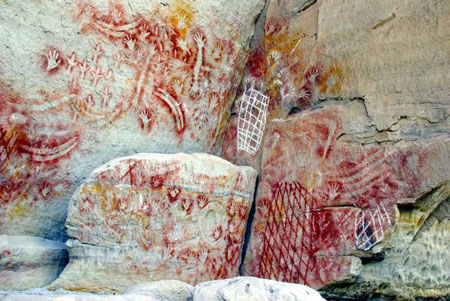Indigenous Australian Art
Australia is a country with wonderful people, wonderful wilderness, and most importantly, passionate artists. The art that the indigenous Australian people create has been sold around the world due to its popularity. Indigenous people of Australia are also known as Aboriginals and are the original residents of the country.

Two main categories of indigenous art exist. Traditional art is works that were created before the country was colonized. The other category is contemporary indigenous art. Contemporary art, in the case of Australian Aboriginal art, refers to art made with methods introduced after colonization of Australia.
Traditional Indigenous Australian Art
Before colonization of Australia the Aboriginal people had a wide variety of art styles that were unique to them. Styles from rock painting to bark painting, sculpture crafting and weaving, all were crafts that you could find among groups of the aboriginal people. While other countries had developed similar art styles, the indigenous Australians had their own take on each craft.
It is important to note that while we use was for most of this article, art that is carried out in a traditional manner by aboriginal people is often still considered to be traditional art. Plenty of artists still use traditional methods without contemporary influence.
We are going to take a closer look at the major indigenous Australian art styles.
SEE: Type of Printing & Printers for the Artwork Printing Process
Rock Art
Many older cultures developed forms of art that involved rocks as a medium. The people of Australia developed a variety of rock-based art styles. More than three different styles, in fact.
Rock painting was very popular in Australian history. In the Northern Territory especially, a type of art known as x-ray art developed. In this form of art, animals and humans were drawn in skeletonized form. Almost as if they were being drawn as seen by an x-ray. However, x-rays did not exist at the time this artwork became popular. It was drawn based on the observation of remains. You may also hear this art referred to as cross hatch.
Dot painting used patterns of dots to create figures and tell stories. Art in this form was found in the deserts of Australia, especially in Central and Western Australia.
Using hands and other stencils to paint onto rocks can also be found in traditional art of the Australian people.
Sometimes Papunya art would be crafted on rocks. In this type of art, yellow, brown, red, and white colours were used to represent the sun, soil, desert sand, and sky respectively. This set of colours are considered Aboriginal colours, they were used in a lot of their art. Papunya art was depictions of stories and legends using this colour. Sometimes these were real life stories, other times they were Dreamtime stories.
Dreamtime scapes are those that are either time out of time or whenever scapes. While a topic for another article, Dreamtime often featured ancestral figures, cultural heroes, and other figures that may not appear in the normal world. Sometimes these included gods, but they were often separate from what the indigenous people considered gods.
When it came to painted rock art, it was one of the earliest forms of art found in Australia. Examples can be found around the country in parks, deserts, and other pieces of land. Paints made from a wide variety of materials were used to craft this art. Charcoal has also been used by indigenous Australians to create art.
The last type of art that involves rocks is rock engraving. This type of art is similar to the other art forms with the difference being the art was engraved instead of painted on. A variety of styles have been found around the country from all time periods.
Wood Carvings
Punu wood carvings played a big role in indigenous culture. These pieces of art were made with sharp stones, wire, and fire. The people of Australia created amazing works of art using one of those methods, or sometimes all three combined. Each piece either told its own story or, when combined with others, helped to tell a story. As such, receiving one of these items was more than getting a small piece of wood. You were getting a piece of culture.
In later days these wood carvings were traded to foreigners in exchange for foreign goods or luxuries.
Weaving
Aboriginal art work included weaving of a variety of different objects. Baskets were popular but a variety of other things were also made. Often times the weaving arts of traditional aboriginal people were for both artistic means and practical ones.
String Art
The last traditional type of art we will talk about is string art. Aboriginal people would create images and artwork using strings. By manipulating the string with their fingers different shapes and designs could be created temporarily.
